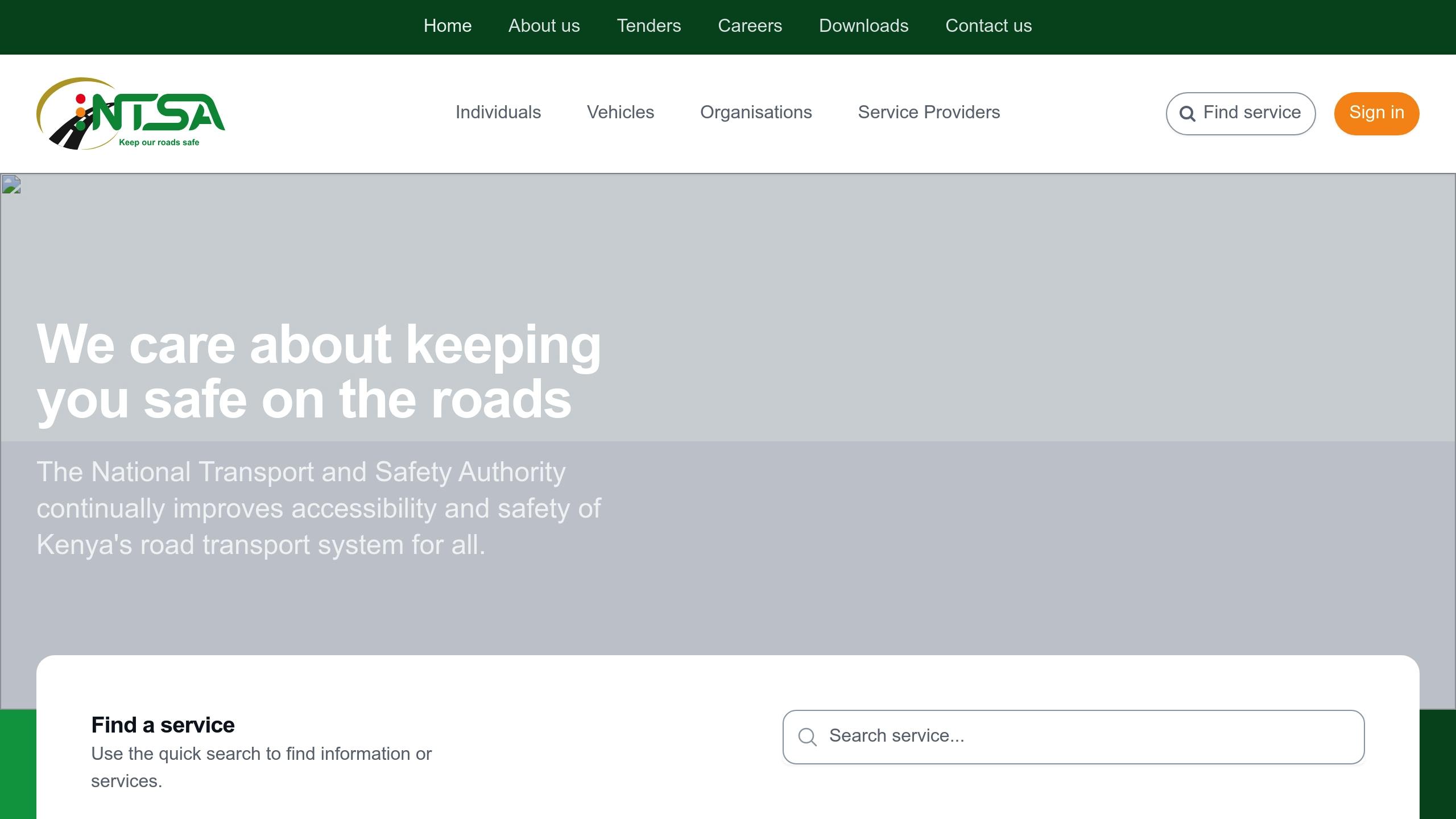Kenya’s NTSA has introduced new 2025 roadworthiness rules for commercial vehicles to reduce accidents, improve safety, and cut economic losses. Here’s what you need to know:
- Key Changes: Mandatory telematics systems, underride protection devices, and retro-reflective markings.
- Annual Inspections: Replacing the previous biennial checks.
- Compliance Costs: About KES 150,000 per vehicle, with incentives like VAT rebates and duty exemptions.
- Phased Deadlines: 6-12 months based on vehicle type.
- Penalties: Fines up to KES 200,000 and potential license suspensions for repeat violations.
These updates aim to tackle mechanical failures (35% of crashes in 2024) and speed-related accidents (42% of fatalities), aligning with global safety standards. Operators must act quickly to meet these requirements and ensure compliance.
NTSA New Rules on Vehicle Inspections

Main Requirements for 2025
The NTSA’s 2025 regulations introduce updated safety standards for commercial vehicles in Kenya. These rules focus on three main areas: safety equipment, vehicle testing, and digital monitoring systems.
Safety Equipment
Commercial vehicles are required to install KEBS-certified speed limiters that comply with KS 2295:2018 standards. These devices must be calibrated at NTSA-approved garages to address concerns, as speeding contributes to 42% of fatal crashes in Kenya [1][2].
To improve visibility, vehicles must include retro-reflective contour markings at least two inches wide. The markings follow a specific color-coding system based on vehicle type:
| Vehicle Type | Marking Color |
|---|---|
| Buses | Yellow |
| Trucks | White |
| Tankers | Red |
Additionally, steel barriers are mandatory to protect against roof shearing during accidents [1][3].
Vehicle Testing
The 2025 regulations make annual inspections mandatory for all commercial vehicles, replacing the previous biennial requirement [1][2]. These inspections also incorporate updated emissions standards as outlined in KS 1515:2024 [4][5].
Digital Monitoring Systems
One of the major updates is the mandatory integration of telematics systems with NTSA’s National Telematics Hub [2][3]. These systems are designed to track:
- Real-time GPS locations
- Engine diagnostics
- Driver behavior
- Automated incident reporting
Fleet operators are required to keep 90-day rolling logs of vehicle performance data. Any critical incidents must be reported to NTSA within 24 hours [2][3].
These systems are central to the enforcement measures outlined in the Rules Rollout timeline below.
Rules Rollout and Enforcement
Kenya’s NTSA is enforcing these new regulations using Africa’s first telematics-linked penalty system. This builds on the digital monitoring framework introduced earlier.
Timeline by Vehicle Type
NTSA has set phased deadlines for different vehicle categories:
| Vehicle Category | Compliance Deadline | Key Requirements |
|---|---|---|
| Passenger Service Vehicles | 6 months | Telematics compliance |
| Heavy Goods Vehicles (>3.5T) | 9 months | Contour markings |
| Specialized Vehicles | 12 months | Category-specific safety equipment |
New vehicle registrations must comply immediately, while existing fleets follow this phased schedule [1][4]. To ensure adherence, NTSA will use mobile inspection units [1][3].
Fines and Penalties
The 2025 regulations introduce a structured system of fines and penalties for non-compliance. Fines range from KES 50,000 for marking violations to KES 200,000 for missing underride protection. Critical failures may lead to vehicle impoundment [1][2][3].
Operational Impact: Fleet operators are subject to a tiered rating system based on compliance levels. This system directly affects their business operations:
| Rating Level | Compliance % | Consequences |
|---|---|---|
| Gold | 90-100% | Priority inspection slots |
| Silver | 75-89% | Standard processing |
| Bronze | Below 75% | Enhanced monitoring |
Repeat violations can result in license suspensions (30-180 days) and bans from government tenders [1][3]. NTSA will also publish quarterly compliance reports, naming repeat offenders.
Operators have a 45-day grace period for verified repairs at NTSA-authorized facilities [2][4]. Emergency service vehicles are exempt from nighttime marking requirements, and agricultural transporters have extended deadlines for telematics compliance.
To avoid gaps, operators must keep KEBS installation certificates and telematics logs for inspections. Only NTSA-approved vendors should be used for installations [1][5].
sbb-itb-e5ed0ed
Old vs New Rules
The 2025 NTSA regulations update the standards set in 2018, focusing on a predictive safety management approach. These updates aim to address the KES 300 billion annual accident costs mentioned earlier.
Changes Summary Table
Here’s a breakdown of how the new framework changes key aspects of commercial vehicle operations:
| Aspect | Previous Standards | 2025 Requirements | Operator Impact |
|---|---|---|---|
| Vehicle Monitoring | Optional systems | Enhanced monitoring protocols | Higher compliance rates |
| Safety Equipment | Basic reflectors, first aid kit | KEBS-certified 2" reflective markings, pressure-checked fire extinguishers | Better visibility |
| Breakdown Protocol | 30m warning triangle distance | 50m warning triangle placement | Better accident prevention |
| Vehicle Age | 10-year import limit | 8-year import limit | 15% increase in fleet costs [5] |
| Inspection Frequency | Biennial checks | Annual inspections | Easier verification [2] |
| Collision Protection | Standard safety features | Enhanced protection systems | Lower collision severity [3] |
| Documentation | Paper-based records | Integrated digital systems | Better tracking [1] |
| Emissions Control | Basic controls | Euro IV standards compliance | 12% rise in operating costs [4] |
Technical Updates
All chassis modifications now require KEBS certification, and non-standard body builds on imported truck frames are no longer allowed [4][5]. Previously, only modifications affecting structural integrity were restricted. These stricter rules support NTSA’s safety goals by ensuring stronger structural standards.
Environmental Standards
The new rules also introduce tighter environmental requirements. Operators must now monitor emissions regularly using telematics systems. This builds on existing telematics logging rules and ensures a more thorough approach to emissions oversight [4][5].
"The digital inspection system implementation has already demonstrated an 82% reduction in fraudulent certification cases during trials, validating our approach to modernizing vehicle compliance monitoring", says NTSA’s technical department [1][3].
With phased deadlines in place, operators must upgrade their systems and practices to meet these international safety and environmental standards.
How to Meet 2025 Standards
To align with NTSA’s 2025 standards, operators need to focus on three main areas: upgrading equipment, maintaining proper documentation, and ensuring staff training. These steps aim to address the KES 300 billion annual accident costs that prompted these regulations.
Operators should match their vehicle categories with the phased deadlines listed in the Rules Rollout. The goal is to meet and sustain KEBS certification across all aspects of operations.
A real-world example? SafeHaul Ltd. saw a 30% drop in speeding incidents after implementing the standards early [4].
Financial Planning
The average compliance cost per vehicle is around KES 150,000, but operators can reduce this by leveraging available incentives:
- 15% VAT rebate for KEBS-certified equipment
- 50% first-year depreciation on telematics investments
- Duty exemptions for retrofit tools (valid until December 2026) [6][4]
Documentation Requirements
Operators must keep records such as KEBS certificates, NTSA service logs, and telematics data [1][2][6].
Updates and Information
Keeping up with regulatory updates is crucial for staying compliant. AutoMag.co.ke offers helpful resources, including:
- Digital compliance checklists
- A directory of verified equipment suppliers
- Webinars led by industry experts
- Templates for managing documentation [4]
Additionally, the NTSA is hosting free workshops in major cities to assist operators with the transition [7]. Stay tuned to NTSA alerts for the latest updates and requirements.
FAQs
How to check vehicle inspection status in Kenya online?
You can easily check your vehicle’s inspection status through NTSA’s TIMS portal. Here’s how:
- Log in to the TIMS Portal: Go to https://tims.ntsa.go.ke/ and sign in with your account credentials [2][7].
- Use the Dashboard: Once logged in, click on ‘Vehicle > Inspection Status’ [2].
- Check Your Status: You’ll see details like:
- Dates for the last and next inspections
- Compliance status
- Any pending requirements
2025 Portal Updates
The TIMS portal now offers advanced features, including:
- Real-time OBD-II scan results
- Brake performance test information
- Digital KEBS certification updates [4][5]
Tip: Turn on SMS reminders in your account settings to stay updated on inspection deadlines [7].
| Feature | Details | Refresh Rate |
|---|---|---|
| Fleet Overview | Inspection status for all vehicles | Real-time |
| Compliance Alerts | Notifications for deadlines and issues | Daily |
| Digital Certificates | Downloadable inspection reports | After each inspection |
These updates align with the tiered rating system for operators explained under Fines and Penalties.
If you face any trouble accessing the portal, NTSA’s support team is available at their Upperhill office in Nairobi or via their 24/7 helpline [2][7].
Related Blog Posts
- FAQ: Importing Used Cars to Kenya in 2025
- Ultimate Guide to Off-Road Safety in Kenya
- Ultimate Guide to Car Maintenance Budgeting in Kenya
- Ultimate Guide to Eco-Driving in Kenya




